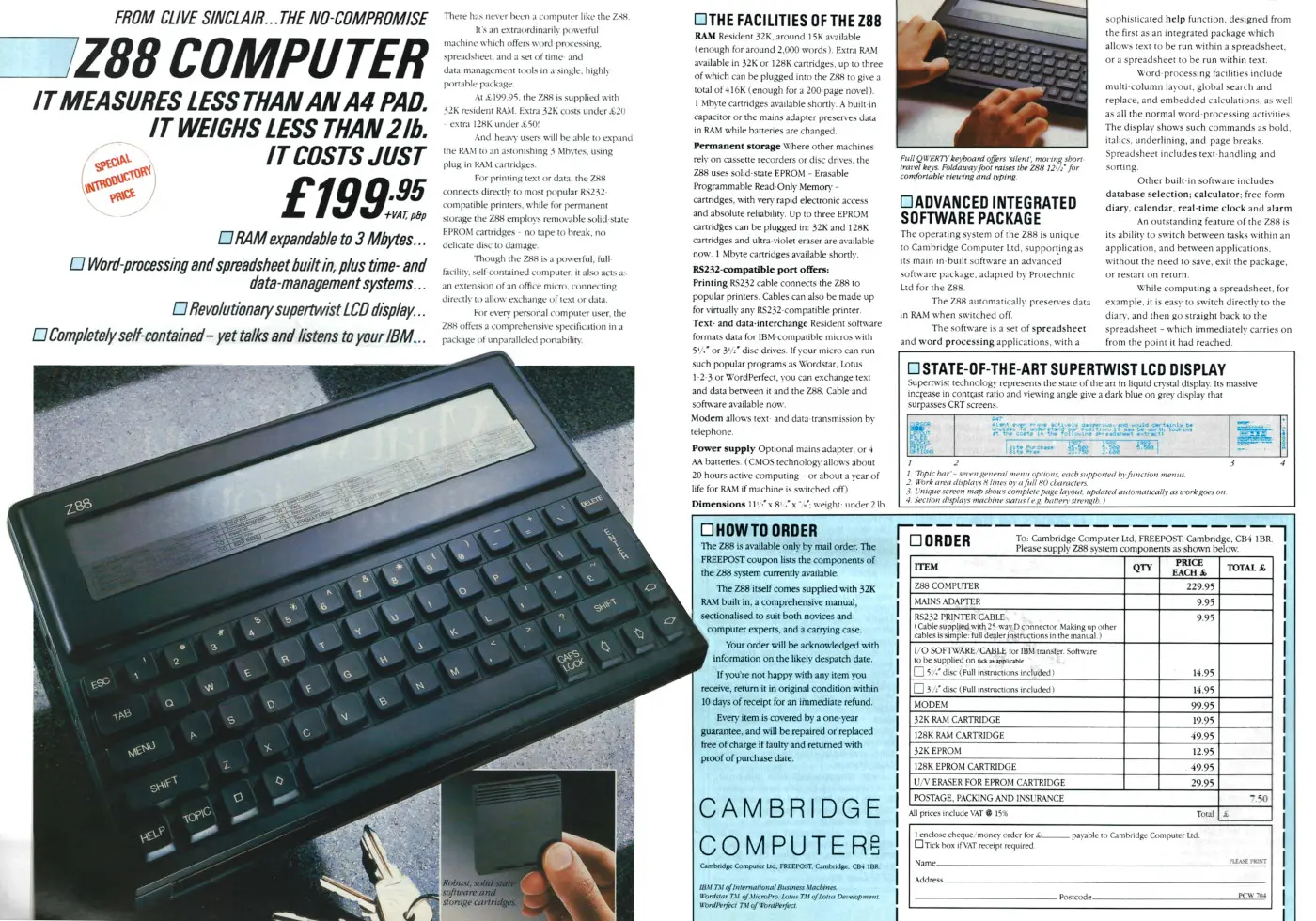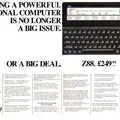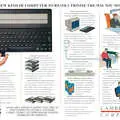
Cambridge Computer Advert - April 1987
From Personal Computer World

From Clive Sinclair: The No-Compromise Z88 Computer
After the financial turmoil bought on by the QL fiasco - late delivery, dodgy early firmware, and the curse of the Microdrive - together with other disasters like the Pocket TV and the C5, developed by spin-off company Sinclair Vehicles, Sinclair Research ran out of fiscal steam towards the end of 1985.
Even a £12 million take-over by media-baron Robert Maxwell, which had been instigated by the Bank of England and and which was scheduled to have been completed in September of that year, had fallen through.
Nevertheless, creditors, which included Thorn-EMI, Timex, AB Electronics (which also built Acorn's BBC and Electron), Barclays Bank and Citibank[1], were "generous" enough to let Sinclair see through the all-important Christmas sales period.
This should have allowed the company to release the rumoured and potentially company-saving Spectrum 128, which was thought to be based upon technology co-developed for Timex US's unsuccessful TS2000 model way back in the summer of 1983. This included the all-important 128K bank switching, hi-res graphics and an MSX-like sound chip [2].
The company was also expected to release the fabled Pandora portable and the QL II[3], however, it was all over by April 1986 and Amstrad - the brash New Kid on the Block, which had come from nowhere to conquer the market with its range of cheap, well-specced, all-in-ones - bought Sinclair's marketing and merchandising rights for £5 million (£18 million in 2025).
This left Sinclair with the debt-laden Sinclair Research[4], which became known as SRL.
Whilst talking about the fabled machine, Personal Computer World's Guy Kewney asked Alan Sugar whether he'd bought the rights to the Pandora. Sugar apparently said "Have you seen it?". "Yes" said Kewney. "well then" said Sugar[5].
The Pandora never saw the light of day, but the following year Clive Sinclair returned from the wilderness with a new company spun out of his Sinclair Research (SRL) holding company - Cambridge Computer - and a new machine, the portable Z88.
The late Rick Dickinson - Sinclair's former product designer who had designed the ZX81 and QL cases, and who by this time was an industrial design consultant - shows in a Flickr album how the case design of the Z88 evolved from that of the Pandora. However, the technology appeared to be less portable.
Referring to the Pandora project in an interview in November's Your Computer, Sinclair said, when asked how much of the Pandora carried over in to the Z88:
"Well, the basic philosophy is very similar, but when it came to the design we started from scratch with a clean sheet of paper. It was lucky we had the opportunity, because we were running up against a brick wall at that point. The display technology on the Pandora was a flat screen similar in concept to the pocket television, with an optical system to blow it up to a decent size. It was very good, but it couldn't quite give us a display 80 characters wide. We went up to about 66 characters but couldn't do any better. We were just lucky when Supertwist [LCD] technology came along when it did"[6].
Somewhat ironically, when interviewed back in 1985, Sinclair had discussed the "Spectrum Portable" and had at the time explicitly ruled out LCD technology in favour of Sinclair's own flat-screen TV[7].
However, the biggest problem with the display was said to be that the angle you viewed the display was critial, which was not that helpful for a machine meant to be portable and which would be viewed in a variety of environments[8].
There was much mystery surrounding Supertwist LCDs when the UK's ministry of Defence started writing to various manufacturers in order to obtain licencing agreements for the technology that it had developed back in 1982, when it was invented at the Royal Signals and Radar Establishment in Malvern, Worcestershire.
Sinclair, who was using Supertwist in the Z88 was unaware of any direct approach by the MOD, as was Epson, which made the display for Cambridge Computer, although Epson's UK comms manager Edward Huggins was "aware of the MOD's concern".
The MOD had secured patents in the UK, the US and Canada, and was expecting a European patent "soon" with a Japanese patent in 12 to 18 months.
Meanwhile, nobody knew what, if any, effect complying with the patent would have on the Z88's price[9].
Late again

Clive Sinclair, as illustrated for Your Computer with a Z88 reflected in his sunglasses, © Your Computer November 1987The Z88 had been released to some acclaim, although in true Sinclair style it was some three months later than the originally-promised April.
The delay was blamed on writing its software, the contract for which was still unsigned as late as December 1986, with problems producing a coherent software suite being suggested.
Sinclair said "It's still not complete, we've got the chunks, now they need to be merged into one"[10].
Sinclair also pointed out that a second production line, in addition to Thorne Datatech's, was to be set up to help reduce delays. "The deal hasn't been signed, so I can't name names at the moment, but the second line will be there".
When the Z88 finally started rolling off the production line, Clive Sinclair said "We started shipping them out last Saturday [27th June 1987] and we should be up-to-date within two weeks"[11].
Sinclair, who was quoted from five years before as saying "If we announce a product now, it is because it is ready for production", had also got into trouble with the Advertising Standards Authority as it upheld various consumer complaints that no expected delivery date had been mentioned in the Which Computer? adverts for the machine.
This put the company in breach of the Code of Advertising Practice, which mandated that goods advertised by mail order must arrive within 28 days - a clause that Sir Clive's previous company Sinclair Research had been singularly adept at failing to comply with.
Adverts for the Z88, meanwhile, had only offered a "likely despatch date" whilst still requiring that potential customers send their cheques in with their order.
Sir Clive was said to have been "astonished" at the criticism levelled at the company[12], whilst in the following week Sir Clive was on the defensive, suggesting that ASA concerns were unfounded.
With history perhaps influencing opinion, given delays over Microdrives, the QL and even the C5, it was perhaps not unexpected, but Sinclair was "adamant", stating that "the software is on schedule, production of the machine should start in April, and the first customers should receive their machines in the second half of April".
Only the modem was delayed, as apparently that was stuck awaiting BABT approval[13].
By July, Sir Clive was claiming that over half the orders for the Z88 had been fulfilled and that he was expecting to be "bang up to date" by the following week.
He also expressed surprise over the furore about advertising, and took particular exception to an article in Popular Computing Weekly over delayed deliveries of the machine. "The ASA had only one complaint about the advertising of the Z88 - just one, which is hardly strong criticism".
He went on "They asked us to put the '28 days delivery' notice on it, which we hadn't done before because it wasn't to be delivered in 28 days. Really, the whole thing got out of proportion".
The company was also sure that the Z88 would soon be sold in retail outlets, although marketing manager Peter King wouldn't name any of them.
Sinclair reckoned that "a number of retailers have agreed to stock the machine" from the end of July[14].
The official launch of the Z88 didn't occur until the first week of September, when the machine finally made it to branches of Comet and Dixons.
The launch was attended by Lalla Ward, who had starred with Tom Baker as Romana in Doctor Who and seemed to be there simply because she had bought a Z88 by mail order and had said "I love it, it's the computer for me".
It was also the moment when the company announced a big manufacturing deal with the UK subsidiary of SCI.
The US company, which had a turnover of $470 million (£1,060 million in 2025) and which also built computers for DEC and ICL, was planning to produce the Z88 at its Irvine plant on the west coast of Scotland[15].
By September 1987, Cambridge Computer was churning out 1,000 Z88's a week, a figure which was expected to quickly double.
Thoughts were already turning to the machine's eventual successor, with perhaps a Z89 or Z90, in the style of the old Sinclair numbering scheme.
However, Clive seemed convinced that the Z88 as it stood was right for the market, suggesting that:
"The thing about the Z88 is the way we've designed it. It can go on being expanded pretty well indefinitely, so obviously there's no need to change the machine because we just plug in different cartridges and expand it. In terms for portables, that's our statement for a long time to come. I think it's not the sort of product that needs changing".
He also took issue - again - with the ASA and his previous run-in over the lack of delivery times, saying:
"We never said it was going to be available in 28 days, because it wasn't. We just said if people were prepared to be one of the first, that's the way to be first and those people who wanted to be first were".
In the interview in September's Popular Computing Weekly, Sinclair discussed his wafer-scale solid-state disc project over at Anamartic, which was still waiting on the signing of a funding deal which would give the spin-off the £4 million it needed to launch the 20MB silicon disk into the market.
Also mentioned was the rumoured Sinclair mobile "pocket" phone project, which was being joint-developed with Shaye Communications, Timex, shipping company Fred Olsen and a certain Nokia-Mobira of Finland, the world's largest manufacturer of cellular radio products[16].
Capitulation
The Z88 was first revealed at the Which Computer? Show in February 1987[17] and initially available only via mail order, however Sinclair announced distribution deals with Dixons and Comet at the end of 1987.
There were also moves to make the machine more compatible with other systems, unlike earlier 8-bit machines which had barely been compatible with themselves, let alone previous models or competitors.
There were utilities to transfer WordStar and Lotus 1-2-3 files to/from the IBM PC, as well as the announcement of forthcoming utilities to communicate with Apple's Macintosh and the BBC Micro.
The latter must have been especially galling, as Sinclair and Acorn had been waging a well-publicised war-of-words for years - from press slanging-matches[18][19] to actual punch-ups in Cambridge pubs[20].
This had been so ever since Chris Curry - Sinclair's right-hand-man in the late 1970s - had left to co-found Acorn with Hermann Hauser, and was immensely exacerbated when Sinclair lost out to Acorn for the lucrative BBC Micro contract.
Sinclair's major beef about that appeared to have been less to do with Acorn and more about the BBC's attempt to set a new standard for software.
Venting in a 1982 interview for Practical Computing, he suggested that the BBC "had the unmitigated gall to think that they could set a standard - the BBC language. It is just sheer arrogance on their part"[21].
So the biggest suprise of the Z88, and perhaps Sir Clive's greatest capitulation, was that the machine ran BBC Basic.
The Dixons and Comet deals appeared to have soured by the end of 1989, as Personal Computer World was suggesting that the Z88 seemed to have disappeared from both retailers.
The reason appeared to be that the volumes that had been negotiated as part of the original deals never materialised and, although sales were perfectly respectable from Cambridge's point of view, they didn't appear to be anywhere near the large volumes that were needed to make a profit on the machine for the High Street sellers.
In January of 1989, Comet started selling the machine at below cost, a move which led Dixons to believe that its competitor had better terms, leading to Dixons breaking the fixed price agreement that the three companies had, with its announcement of a price drop in the summer of '89.
Cambridge Computers, however, was keen to keep the price up, as reducing it too much might mean that its important business buyers could consider it as too toy-like and stop buying it at all.
So when Dixons gave Cambridge an ultimatum - reduce the wholesale price or else - Cambridge told Dixons to get stuffed.
Whilst Dixons immediately dropped its price to £99 to shift remaining stock, Cambridge's new sales and marketing manager Roger Flack swiftly moved the company's whole distribution model to a more-conventional PC style, with a few distributors selling on to around 150 dealers.
There was also some movement in the long-sought-after educational market, as a City Technology College was promising to equip each new student, every year, with a Z88 - a move that if repeated by other colleges could lead to a big increase in units shifted - at least beyond the 35,000 which it was thought had been sold since the machine's debut at the 1987 Which? Computer Show[22].
The Z88 retailed for £199 + VAT, or around £840 in 2025. Within a few months the price was up to £250 + VAT, a situation which was blamed on the strength of the Japanese Yen[23].
Date created: 04 February 2024
Last updated: 11 December 2024
Hint: use left and right cursor keys to navigate between adverts.
Sources
Text and otherwise-uncredited photos © nosher.net 2025. Dollar/GBP conversions, where used, assume $1.50 to £1. "Now" prices are calculated dynamically using average RPI per year.



